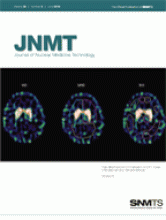
Tamara A. Sloper Intersocietal Accreditation Commission
As an accreditation organization, ICANL is expected to maintain a program that balances the changing needs of both the nuclear medicine/nuclear cardiology/PET imaging community and the general public by improving the quality of patient care. The ICANL Standards are the foundation of that commitment. Composed by physician-, nuclear medicine technologist–, and physicist-sponsoring organization representatives on the ICANL board of directors, including representatives of the SNMTS, the standards are critically reviewed and revised every 2 years.
The latest version, published in 2010, are available for review and download from the ICANL Web site. The new guidelines become effective July 1, 2010. Applicant laboratories will benefit from the enhanced clarity and more inclusive nature of the 2010 version. Most of the changes clarify or explain the previous standards. There are several areas in which the guidelines are now more relaxed. The 2010 version has 5 areas of significant change:
TECHNICAL DIRECTOR REQUIREMENTS
Although specific pathways for documentation of the training and experience necessary remain defined; the laboratory's technical director is no longer required to have 3 years of clinical experience in nuclear medicine.
STRESS TEST SUPERVISION
The standards now specify that all personnel directly supervising stress procedures must have appropriate training or experience. Although a physician presence during stress testing is not required, the facility must ensure that appropriate staff is present, based upon the type of procedure being performed and the patient's risk of adverse events. If a nonphysician (e.g., properly trained nurse, physician assistant, nurse practitioner, exercise physiologist, or technologist) practicing under the physician's license is supervising the stress test, the medical director or physician director of the stress laboratory must attest in writing to the appropriate training and competence of the practitioner as outlined in the American College of Cardiology/American Heart Association Clinical Competence Statement on Stress Testing. In addition, at least 2 qualified individuals are required to be in attendance at the time of radionuclide injection during stress testing (e.g., the person supervising the stress test and the person authorized to inject the radionuclide). The ICANL Standards state that it is preferable for 2 individuals to be in attendance during the entire stress test.
QUALITY CONTROL OF IMAGING AND NONIMAGING EQUIPMENT
The guidelines have been enhanced regarding quality control of imaging and nonimaging equipment. An annual review of quality control protocols is now required. Quality control protocols must include items such as acceptable range or tolerance limits and actions for out-of-tolerance results, as well as instructions for record retention. In addition, the 2010 version of the ICANL Standards now mandate specific documentation of each quality control test performed (i.e., the type of test performed; the date and time of the test; identification of the device tested; the make, model and serial number of any reference sources used; the results of the test; a notation of whether the result was acceptable; and the signature or initials of the individual performing the test).
APPROPRIATE-USE CRITERIA
Appropriate-use criteria are now incorporated as a new section within the ICANL Standards. As part of the laboratory's ongoing quality improvement program, facilities providing nuclear cardiology and cardiac PET imaging are required to measure the appropriate use of radionuclide testing, based upon criteria published or endorsed by professional medical organizations. All other areas of nuclear medicine are encouraged to measure appropriate use as criteria become established and published by the relevant professional medical organizations. The 2010 version specifies that appropriate use must be measured in consecutive (e.g., 2- to 3-week) time periods so that 5% of the annual volume of patients referred for radionuclide testing is evaluated. For smaller-volume laboratories, a minimum of 30 patients must be evaluated. In addition, the overall results must be documented. The percentage of appropriate, inappropriate, and uncertain indications for testing must be measured. The laboratory's development of a program for education and reporting is required and must include patterns of adherence to appropriate-use criteria, baseline rates of adherence, goals for improvement of adherence to appropriate-use criteria, measurement of improvement rate, and confidential comparison reports on patterns of adherence in aggregate by the ordering physician, ordering practice, and interpreting practice. New information on appropriate-use criteria and the new FOCUS community hosted by the American College of Cardiology is available on the ICANL Web site.
EMERGING-TECHNOLOGIES PATHWAY
In 2009, ICANL incorporated a pathway for the acceptance of applications submitted by laboratories utilizing new technologies and other novel imaging approaches not included within the guidelines published by professional societies. The 2010 ICANL Standards reflect the requirement in place for laboratories using standard imaging equipment but utilizing imaging reconstruction algorithms not currently incorporated in the published imaging guidelines (e.g., half-time), as well as laboratories using new hardware technology with Food and Drug Administration 510K clearance that is not incorporated into professional organization guidelines. These laboratories are required to perform a physiologic patient simulator study to determine defect and image reproducibility using the laboratory's actual imaging parameters. In addition, requirements exist related to demonstration of compliance with manufacturers' recommended quality control through the submission of the results of quality control testing. Documentation of adequate training and competency of the technical staff, relevant to the new technology, is also required. For the purpose of accreditation, once a new technology is incorporated into the published professional guidelines, laboratories using the technology will no longer be required to perform physiologic patient simulator studies.
ICANL strives to publish standards that facilitate continuous improvement of the quality of care provided in nuclear medicine, nuclear cardiology, and PET imaging laboratories and looks forward to guiding laboratories toward compliance. Free live webinars summarizing the 2010 ICANL Standards were presented in April and May. For help or more information regarding the revised document or the accreditation process in general, please contact the ICANL staff (800-838-2110) or visit the ICANL Web site (www.icanl.org).







